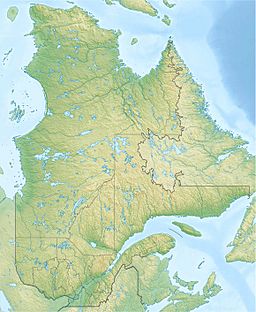Lac aux Biscuits facts for kids
Quick facts for kids Cookies Lake |
|
|---|---|
| Coordinates | 47°38′10″N 72°12′36″W / 47.636°N 72.210°W |
| Primary outflows | Batiscan River |
| Basin countries | Canada |
| Max. length | 2.4 km (1.5 mi) |
| Max. width | 0.8 km (0.50 mi) |
| Surface elevation | 106 m (348 ft) |
| Settlements | Lac-Édouard, Quebec |
Cookies Lake, also known as Lac aux Biscuits in French, is a cool body of water located in the province of Quebec, Canada. It used to be called "Cross Lake" (or "Lac à la Croix"). This lake is found in a beautiful area called Haute-Batiscanie, within the municipality of Lac-Édouard, Quebec. It's part of the Mauricie region.
Cookies Lake is quite important for the area. Its watershed, which is the land area that drains water into the lake, covers about 247 square kilometers. This makes it the sixth largest water body in the Batiscanie region.
Contents
Where is Cookies Lake?
Cookies Lake is about 2.4 kilometers long and 0.8 kilometers wide. It has a large bay towards its northern end. The water from Cookies Lake flows out from its southwest side into a small river. This river is about 2.4 kilometers long and eventually connects to the Batiscan River.
The lake is located about 5.6 kilometers southeast of the village of Lac-Édouard, Quebec. It's also about 48 kilometers northeast of La Tuque, a larger town. The lake's outlet is near Lac-à-la-Croix and the "Club Triton" in the Seigneurie du Triton area.
If you look at the lake's shape, it looks a bit like a crescent moon that's open towards the southeast. It almost wraps around another nearby lake called John-Bull Lake. In the middle of Cookies Lake, you'll find "Blueberries Island" (Île aux Bleuets). This island is right across from where John-Bull Lake's water flows into Cookies Lake.
How Cookies Lake Gets Its Water
Cookies Lake gets its water from two main sources in the northeast:
- The outlet from "Lake Cleveland" flows into it from the northeast.
- The "Travers River" flows in from the east. This river starts at "Travers Lake." Travers Lake itself gets water from "Lake of the Three Caribou" (to its west) and Gauthier Lake (to its east).
Cookies Lake is at the very western edge of a larger area called its sub-watershed. This sub-watershed covers about 243.39 square kilometers. It's considered the northernmost part of the Batiscanie region's headwaters. This means it's one of the highest points where the Batiscan River system begins.
This sub-basin includes many other lakes, like Aberdeen Lake (which is at an altitude of 430 meters), Witherbee Lake, Cleveland Lake, McMilen Lake, Lispenard Lake, and "Lost Plan Lake" (Lac de Plan Perdu).
Cookies Lake is completely surrounded by forests. It also has tall mountains on its northern side. The lake usually freezes over from November until April. The surface of Cookies Lake is about 348 meters above sea level. For comparison, Lac-Édouard, Quebec is at 363 meters. Because of its high elevation and the water bodies that feed it, Cookies Lake is considered a second main source for the Batiscan River.
What's in a Name?
The name "Cookies Lake" (Lac aux biscuits) was officially recognized on December 5, 1968. This was done by the Commission de toponymie du Québec, which is like a government agency that names places in Quebec.
A Look Back in Time
The area around Cookies Lake became more active thanks to a railway built in the late 1800s. This railway connected Hervey-Jonction, Quebec to Chambord, Quebec, passing through Lac-Édouard, Quebec. Travelers and people working in the forests often used the "Gare du Triton" train station, which was located in the Lordship of Triton area.
Cookies Lake has been an important spot for forestry, with the Government of Quebec allowing trees to be cut there. It's also a popular place for hunting and fishing.


